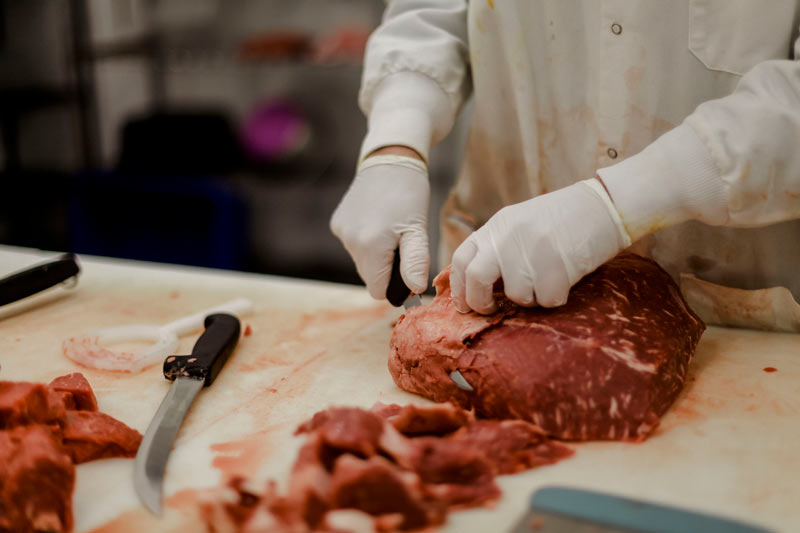How to Select the Perfect Cut of Meat From a Trusted Meat Market
Choosing the perfect cut of meat from a trusted meat market needs a thoughtful technique that balances quality, culinary purpose, and budget. Recognizing the various kinds of meat and their respective cuts is vital, as is involving with your butcher to gain insights right into sourcing and preparation.
Comprehending Meat Cuts


For example, the tenderloin is valued for its buttery structure and marginal connective tissue, making it perfect for fast cooking approaches such as barbecuing or pan-searing. In comparison, tougher cuts like the brisket or shank take advantage of slow-moving food preparation methods to damage down collagen, producing rich and flavorful outcomes.
In addition, the fat material of a cut plays an essential function in taste profile and wetness retention during cooking. Cuts with greater fat content, such as ribeye, offer a more durable flavor, while leaner options, like sirloin, may require cautious prep work to avoid dryness (bagley meat market edwardsville il). Recognizing these nuances permits informed options that boost culinary developments, ensuring that each dish showcases the ideal qualities of the selected meat
Variables to Consider
When choosing the excellent cut of meat, several essential factors come into play that can dramatically impact the final meal. Consider the type of meat you prefer-- beef, pork, lamb, or chicken-- as each deals one-of-a-kind tastes and appearances. The specific cut within that category is similarly important; for instance, ribeye supplies abundant marbling, while tenderloin offers a lean, buttery structure.
Another element is the food preparation approach you plan to use. Cuts ideal for grilling, such as T-bones or sirloins, differ from those much better suited for slow-moving cooking, like chuck roasts or shanks. Additionally, quality is critical; constantly choose meat with a vibrant color and company appearance, signaling top quality and correct handling.
Furthermore, consider the resource of the meat. A relied on meat market frequently provides in your area sourced, hormone-free, and grass-fed alternatives, which can boost flavor and dietary worth. Lastly, your spending plan will certainly guide your choice. Costs cuts may use outstanding taste, yet there are additionally affordable choices that, when prepared appropriately, can produce delicious results. Balancing these variables will help you choose the excellent cut for your culinary requirements.
Questions to Ask Your Butcher
A butcher's know-how can be important when selecting the suitable cut of meat for your cooking ventures. Start by asking regarding the source of the meat.
Following, ask about the different cuts readily available for the kind of meat you choose. A knowledgeable butcher will discuss the nuances of each cut, aiding you pick one that matches your cooking method and wanted end result. Do not hesitate to ask about the best food preparation strategies for a certain cut; butchers typically have suggestions that can boost your dish.
It's additionally sensible to ask about the meat's quality. Inquire about the delivery timetable and just how usually the meat is replenished. This will certainly provide you self-confidence in the quality of what you are acquiring. Ask for suggestions based on your personal preference preferences. An excellent butcher will certainly be eager to share their expertise and suggest cuts that will certainly thrill your taste. Engaging your butcher with these questions can dramatically boost your meat option experience.
Acknowledging High Quality Meat

Texture is another essential read this article factor; top quality meat ought to really feel strong and a little resilient to the touch. Stay clear of any kind of cuts that feel slimed or excessively completely dry, as these can show spoilage or incorrect storage. Additionally, scent plays an important function; fresh meat ought to have a clean, neutral fragrance, while any repulsive or sour odors are red flags.
Last but not least, think about the resource. Investing in from a trusted meat market, where the meat's origin is known, can make sure better criteria. By concentrating on these signs-- shade, marbling, structure, scent, and source-- you can confidently choose cuts that will certainly boost your food preparation and dining experience.
Cooking Approaches for every Cut
Selecting the appropriate cooking technique is critical for maximizing the taste and inflammation of each cut of meat. Different cuts possess distinct features that determine one of the most appropriate food preparation techniques.
For tender cuts, such as filet mignon or ribeye, completely dry warm approaches like grilling, broiling, or pan-searing are suitable. These techniques boost the all-natural tastes while making sure a juicy, succulent appearance. On the other hand, tougher cuts, such as chuck or brisket, advantage from wet heat methods, consisting of braising or sluggish cooking. These methods aid damage down connective cells, resulting in a tender, flavorful dish.
Pork chops and chicken busts are versatile and can be cooked making use of both dry and moist techniques. While cooking or roasting can generate delicious outcomes, poaching or sautéing can keep moisture and inflammation. For lamb, methods like toasting or braising i loved this are suggested, as they enhance the meat's durable flavor.

Final Thought
Finally, choosing the excellent cut of meat from a reputable meat market requires an extensive understanding of meat cuts and consideration of different aspects, consisting of source, high quality, and cooking techniques. Engaging with the butcher via targeted queries can yield important understandings and referrals customized to details cooking requirements. Prioritizing both top quality and budget will enhance the general gastronomic experience, guaranteeing that the selected cut satisfies expectations in both flavor and prep work.